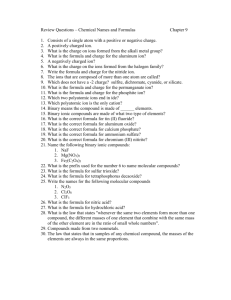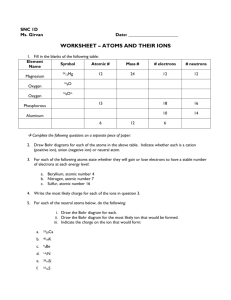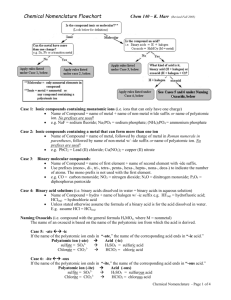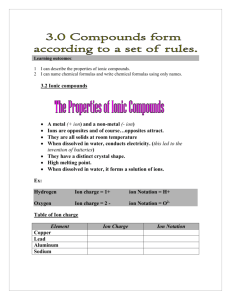Teaching Tips for Lesson 14: Complex Ions
advertisement
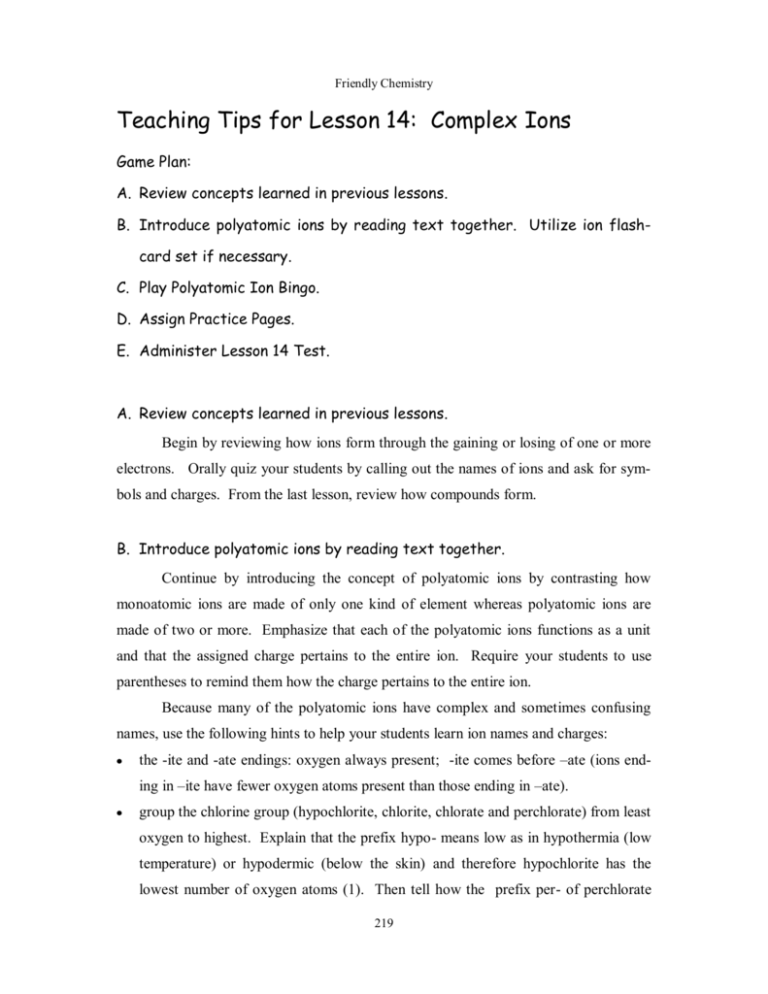
Friendly Chemistry Teaching Tips for Lesson 14: Complex Ions Game Plan: A. Review concepts learned in previous lessons. B. Introduce polyatomic ions by reading text together. Utilize ion flashcard set if necessary. C. Play Polyatomic Ion Bingo. D. Assign Practice Pages. E. Administer Lesson 14 Test. A. Review concepts learned in previous lessons. Begin by reviewing how ions form through the gaining or losing of one or more electrons. Orally quiz your students by calling out the names of ions and ask for symbols and charges. From the last lesson, review how compounds form. B. Introduce polyatomic ions by reading text together. Continue by introducing the concept of polyatomic ions by contrasting how monoatomic ions are made of only one kind of element whereas polyatomic ions are made of two or more. Emphasize that each of the polyatomic ions functions as a unit and that the assigned charge pertains to the entire ion. Require your students to use parentheses to remind them how the charge pertains to the entire ion. Because many of the polyatomic ions have complex and sometimes confusing names, use the following hints to help your students learn ion names and charges: the -ite and -ate endings: oxygen always present; -ite comes before –ate (ions ending in –ite have fewer oxygen atoms present than those ending in –ate). group the chlorine group (hypochlorite, chlorite, chlorate and perchlorate) from least oxygen to highest. Explain that the prefix hypo- means low as in hypothermia (low temperature) or hypodermic (below the skin) and therefore hypochlorite has the lowest number of oxygen atoms (1). Then tell how the prefix per- of perchlorate 219 Friendly Chemistry reminds one of the prefix hyper- meaning extra or above as in hyperthermia (high temperature or hyperactivity (high activity). You can then remember that perchlorate has the most oxygen atoms (4). Finally, show how the chlorite and chlorate then follow the -ite/-ate rule from above. for assistance in learning charges, note that all ions containing chlorine (chloride, hypochlorite, chlorite, chlorate and perchlorate) have a -1 charge (refer back to chloride - it gains one electron when ionizing, therefore a -1 charge); all ions containing sulfur (sulfide, sulfite and sulfate) have a -2 charge. refer to hydronium as “glorified water” - having an extra hydrogen atom (H3O)+1. ammonium can be remembered more easily by thinking about what ammonia is commonly used for in agriculture (fertilizer). The intent of using ammonia is to provide nitrogen to plants. chromium and aluminum are the only +3 ions. phosphate is the only -3 ion. Please note: at this point in the course you will need to decide whether you allow your students access to the master list of ions for future quizzes and tests or not. Most students are capable of memorizing/learning the entire list through the use of the ion flashcard set included with the manipulative set, playing polyatomic bingo (below) and frequent quizzes. Success with the remainder of the course is dependent upon knowing these ions. However, not all students are capable of memorizing so many details and may become easily frustrated. Using professional judgment is important in these cases. One activity I have tried with success with some classes is what I refer to as the “Ion Clubs.” Using a power point program, I’ve created a series of slides which are like an automated flashcard set. I project these onto the wall and have students respond individually with the correct ion symbol and charge. The slide set begins with simple monoatomic ions and progresses to more difficult polyatomic ions with many being repeated through the set. “Ion Clubs” are set achievement levels: the “50 Club” is for students who can, without error, tell 50 consecutive ions. The “100 Club” can be attained by students who can tell the symbol and charge for 100 consecutive ions, etc. We have 220 Friendly Chemistry clubs at the 200, 300 and 400 ion level. To make it reasonably worthwhile, I have provided food-type rewards for attaining certain club levels. This idea works for some classes, but not for others. Again, knowing the abilities and personalities of your students will determine whether this type of activity is suitable. C. Play Polyatomic Ion Bingo. Your students will have blank Polyatomic Ion Bingo cards in their texts. Have your students fill the empty spaces on the cards with symbols and charges for the polyatomic ions you wish them to begin learning. Play by calling the ion names from your Ion Flashcards or from the list on page 227 (S129). Modify play by making new cards which have ion names (rather than symbols) in the blank spaces. Play by calling the ion symbols and charges while your students find the correct names on their cards. As with Ion Bingo, require that your students identify the ions which complete the winning “bingo.” It is considered time well spent if you play Polyatomic Ion Bingo with your students for several consecutive days. Consider allowing your students to earn bonus points on subsequent tests according to the number of bingos they get while playing. In addition, “food prizes” are often welcomed by most students! D. Assign Practice Pages. E. Administer Lesson 14 Test. 221 Friendly Chemistry Name___________________________________________Date___________________ Friendly Chemistry Lesson 14 Test Polyatomic Ions Below is a chart with the names of several of the ions we have been studying. Write the correct symbol and charge or name for these ions. Take your time and do your best job! Ion name Ion symbol and charge Ion symbol and charge 1. sodium cation 17. (ClO3)-1 2. sulfite 18. Br-1 3. phosphate 19. Hg+2 4. perchlorate 20. (NO3)-1 5. iodide 21. (PO4)-3 6. chlorate 22. (OH)-1 7. sulfate 23. (ClO4)-1 8. lead (IV) 24. (MnO4)-1 9. oxide 25. H+1 10. sulfide 26. (ClO2)-1 11. hypochlorite 27. Cl-1 12. ammonium 28. (SO3)-2 13. dichromate 29. (CrO4)-2 14. carbonate 30. (NH4)+1 15. peroxide 31. (O2)-2 16. hydroxide 32. Na+1 222 Ion name Friendly Chemistry Lesson 14: Learning (some slightly) More Complex Ions In the last lesson, we discussed how atoms form compounds by transferring or sharing valence electrons. We discussed the idea that atoms form compounds in order to acquire a more stable electron configuration. In this lesson, we will explore ions which are somewhat more complex than those we examined previously which also join to form compounds. Let’s get started! The ions we examined in the last lesson (both positively charged cations and negatively charged anions) consisted of single atoms. Each ion only had one type of element present. These ions are known as monatomic ions (mono- meaning one). The ions we will explore in this lesson are made up of two or more types of elements. Ions made up of more than one type of element are known as polyatomic ions (poly- meaning many). We will also examine ions which have more than one charge. In some chemistry texts you may find that instead of the word “charge”, the word “oxidation 223 S125 Friendly Chemistry state” is used. Both terms are correct. We will continue to use the word “charge” in our discussions. Let’s begin by discussing some features of polyatomic ions. Like the monatomic ions, polyatomic ions can be cations (positively charged) or anions (negatively charged). It is important to realize that even though the polyatomic ions are made up of two or more elements, the ion acts as one unit and the charge for the polyatomic ion is for the whole unit. When writing the formula for a polyatomic ion, it is customary to enclose the element symbols within parentheses and place the charge outside the parentheses to indicate the charge is for the ion as a whole (and not for any individual component within the polyatomic ion). Look at these examples. Nitrate is a polyatomic anion made up of one nitrogen atom and three oxygen atoms. Its formula is (N1O3)-1. Note that the –1 charge is for the entire nitrate ion and not for any individual portion of the ion. Hydroxide is a polyatomic anion made up of one hydrogen atom and one oxygen atom. Its formula is (O1H1)-1. Note that the –1 charge is for the entire hydroxide ion and not for any individual portion of the ion. Ammonium is a polyatomic cation made up of one nitrogen atom and four hydrogen atoms. Its formula is (N1H4)+1. Note that the +1 charge is for the entire ammonium ion and not for any individual portion of the ion. Hydronium is a polyatomic cation composed of three hydrogen atoms and one oxygen atom. Its formula is (H3O)+1. Note that the +1 charge is for the entire hydronium ion and not for any individual portion of the ion. S126 224 Friendly Chemistry The names of the polyatomic ions may seem confusing at first, but there are some keys which can give you clues to what ions are present in the polyatomic ion. 1. Polyatomic ion names which have the ending “-ite” or “-ate” always have oxygen present. For example, nitrite is composed of nitrogen and oxygen. Sulfate is composed of sulfur and oxygen. 2. In addition, the ions which end in “-ite” always have one less oxygen than those ions ending in “-ate”. For example, nitrite has two atoms of oxygen where nitrate has three atoms of oxygen. Sulfite has three atoms of oxygen where sulfate has four atoms of oxygen. 3. Ions with the –ide, -ite or –ate endings are always negatively charged. 4. The prefix hypo– means low. Hypochlorite as a very low amount of oxygen atoms present. 5. The prefix per- (which can be considered a shortened form of hyper-) means high or excess. Perchlorate or permanganate each carry a “heavier” load of oxygen atoms (both having four oxygen atoms each). 6. For certain ions having more than one charge, it is customary to used Roman Numerals to designate the charge intended for the ion in the name of compound. For example, the element mercury can have two possible charges: +1 and +2. When writing the name for mercury with the +1 charge, we write mercury (I) and when writing the name for mercury with the +2 charge, we write mercury (II). See your Master Ion list for additional ions that utilize Roman Numerals to indicate their charge (lower right column). Note that these ions are always positively charged ions (cations)! Plus, here are some memory “helpers” to assist you in learning the symbols and charges for these ions. 1. For the ions sulfate and sulfite: “We get out of school between 3 and 4, but sometimes at 2 on Fridays.” Sulfite has 3 oxygens, sulfate has 4 while the charge for both ions is a –2. The letter “s” of school links this mnemonic rule to the sulfates. 225 S127 Friendly Chemistry 2. For the ions nitrite and nitrate: It’s night between 2 and 3, but darker at 1. The term night links this mnemonic to the nitrite/ate set of ions. Nitrite has two oxygens while nitrate has 3 oxygen atoms. Both of them have a –1 charge. 3. To help remember the charges for the cations chromium and aluminum: Chromium and Aluminum are 3rd cousins. Both have a +3 charge. 4. For all chlorine containing anions: It’s hot around the pool at 1. All chlorine containing anions have a negative one charge. Chlorine is used in swimming pool water. 5. For the anion, phosphate: It takes four matches to make a fire, but three will work. Phosphate is used in making matches and has four oxygen atoms and a –3 charge. 6. For the hydronium cation: Hydronium is glorified water. Water has two hydrogen atoms, but hydronium is glorified by having three hydrogen atoms! 7. For the nickel cation: The “N” symbol looks like the number two (only on its side). This is also useful for the zinc cation: The “Z” looks like a two. Both cations have +2 charges. 8. For the chromate and dichromate anions: The chromates are relatives of the sulfates—both having –2 charges. 9. For the carbonate ion: If you drink a Coke at 3, you’ll be up until 2. Carbonate is an ingredient used to make carbonated water found in pop. Carbonate has three oxygen atoms and a –2 charge. 10. For the hydroxide ion: “Oh, it’s a hydrox cookie.” The “oh” is the symbol for the hydroxide ion. (Hydrox cookies are a form of Oreos available in the Midwest in case this memory aid makes no sense to you!) S128 226 Friendly Chemistry Name_________________________________Date___________________ Friendly Chemistry Master List of Ions Anions (-) Cations (+) Acetate (C2H3O2)-1 Aluminum Al+3 Bromide Br-1 Chromium Cr+3 Carbonate (CO3)-2 Hydrogen H+1 Chloride Cl-1 Sodium Na+1 Hypochlorite (ClO1)-1 Lithium Li+1 Chlorite (ClO2)-1 Potassium K+1 Chlorate (ClO3)-1 Calcium Ca+2 Perchlorate (ClO4)-1 Magnesium Mg+2 Fluoride F-1 Strontium Sr+2 Iodide I-1 Nickel Ni+2 Oxide O-2 Zinc Zn+2 Sulfide S-2 Silver Ag+1 Sulfite (SO3)-2 Hydronium (H3O)+1 Sulfate (SO4)-2 Cesium Cs+1 Nitrite (NO2)-1 Ammonium (NH4)+1 Nitrate (NO3)-1 Mercury (I) Hg+1 Chromate (CrO4)-2 Mercury (II) Hg+2 Dichromate (Cr2O7)-2 Copper (I) Cu+1 Cyanide (CN)-1 Copper (II) Cu+2 Permanganate (MnO4)-1 Tin (II) Sn+2 Peroxide (O2)-2 Tin (IV) Sn+4 Phosphate (PO4)-3 Lead (II), (IV) Pb+2 Pb+4 Hydroxide (OH)-1 Iron (II), (III) Fe+2 Fe+3 227 S129 Friendly Chemistry Polyatomic Ion Bingo! Write the ion symbols and charges in the spaces below. Include one “free space!” As the ion names are called place a marker on the appropriate ion symbol. Call “bingo” when you get six across, six down or six diagonally and then tell the ions you used to make the bingo to win your prize!!! NH4+1 S130 228 Friendly Chemistry Name_________________________________Date___________________ Friendly Chemistry Lesson 14: Ion Practice - 1 Below is a chart with the names of several of the ions we have been studying. Write the correct symbol and charge or name for these ions. Use your master sheet to make sure you are writing the correct symbols, charges or names! Ion name Ion symbol and charge Ion symbol and charge 1. Calcium cation 19. (C2H3O2)-1 2. Sodium cation 20. I-1 3. Fluoride 21. (NO2)-1 4. Chloride 22. (CN)-1 5. Hypochlorite 23. Ni+2 6. Chlorite 24. Sn+2 7. Perchlorate 25. Ag+1 8. Sulfite 26. S-2 9. Sulfate 27. Sn+4 10. Nitrate 28. (ClO1)-1 11. Nitrite 29. (SO4)-2 12. Hydroxide 30. (ClO3)-1 13. Zinc 31. (ClO4)-1 14. Hydrogen cation 32. (ClO2)-1 15. Chromate 33. (ClO1)-1 16. Dichromate 34. (OH)-1 17. Silver cation 35. Li+1 18. Nickel cation 36. Ba+2 229 Ion name S131 Friendly Chemistry Name_________________________________Date___________________ Friendly Chemistry Lesson 14: Ion Practice - 2 Complete the chart below by writing the appropriate ion symbol and charge or ion name. Ion name S132 Ion symbol and charge Ion symbol and charge 1. sulfate 17. (ClO3)-1 2. sulfite 18. Br-1 3. oxide 19. Hg+2 4. perchlorate 20. (NO3)-1 5. iodide 21. (PO4)-3 6. Lithium cation 22. (OH)-1 7. Sodium cation 23. (ClO4)-1 8. Lead (II) 24. (MnO4)-1 9. phosphate 25. H+1 10. sulfide 26. (ClO2)-1 11. hypochlorite 27. Cl-1 12. ammonium 28. (SO3)-2 13. Calcium cation 29. (CrO4)-2 14. Potassium cation 30. (NH4)+1 15. Barium cation 31. (O2)-2 16. hydroxide 32. Na+1 230 Ion name Friendly Chemistry Name_________________________________Date___________________ Friendly Chemistry Lesson 14: Ion Practice –3 Complete the chart below by writing the appropriate ion symbol and charge or ion name. Ion name Ion symbol and charge Ion symbol and charge 1. Chlorite 19. Sn+4 2. Sodium cation 20. I-1 3. Sulfite 21. (ClO1)-1 4. Chloride 22. (CN)-1 5. Nitrate 23. (SO4)-2 6. Calcium cation 24. Sn+2 7. Perchlorate 25. Ag+1 8. Zinc 26. S-2 9. Sulfate 27. (C2H3O2)-1 10. Hypochlorite 28. (ClO1)-1 11. Nitrite 29. Ni+2 12. Hydroxide 30. (ClO3)-1 13. Fluoride 31. (ClO4)-1 14. Hydrogen cation 32. Na+1 15. Nickel cation 33. (NO2)-1 16. Dichromate 34. (OH)-1 17. Silver cation 35. (ClO2)-1 18. Chromate 36. Sr+2 231 Ion name S133 Friendly Chemistry Notes S134 232
